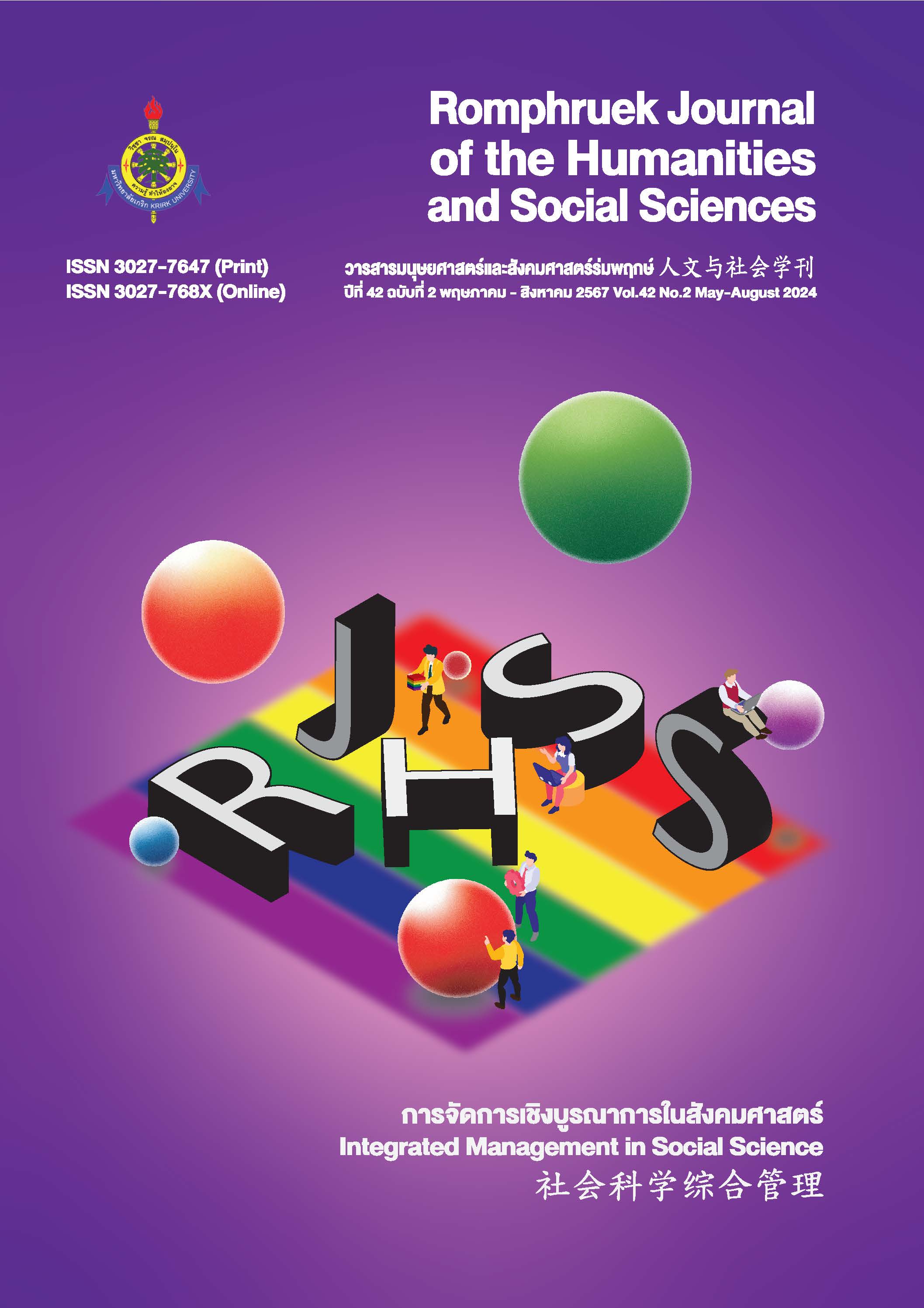Prevalence and Factors Affecting Depression in Online Learning among Undergraduate Students in Bangkok
Main Article Content
Abstract
This qualitative study aims to 1) evaluate the depression prevalence and contributing factors in online learning among undergraduate students in Bangkok, and to 2) analyze the factors associated with depression in online learning among undergraduate students in Bangkok. Data were collected between July 2021 and November 2021. 30,288 students were selected as samples using sampling the sample according to the proportion of the population and using a simple sampling method. The online questionnaire was the research tool. The data collected were analyzed by 1) descriptive statistics to describe the characteristics of depressed person, 2) simple logistic regression analysis to analyze single variables by pairs, and 3) multiple logistics regression analysis to analyze multivariate relationships by the adjusted odds ratio (ORadj) and 95% CI at a significance level of 0.05.
The results showed that there were 230 out of 352 students with depression from online learning. The prevalence of online learning depression was 65.3 percent. Correlation analysis for single variables factors associated with depression were found with statistical significance. These included having identity (OR=2.48; 95%CI=1.16-5.33); moderate stress from studying online (OR=5.78; 95%CI=2.24-14.94); high stress from studying online (OR=15.76; 95%CI=5.96-41.68); moderate self-esteem (OR=1.58; 95%CI=0.51-4.87); and high self-esteem (OR=1.37; 95%CI=0.46-3.84). Furthermore, the result of the correlation analysis of logistic regression variables found that the factors associated with the incidence of depression were statistically significant, including: moderate stress from studying online (ORadj=4.94;95%CI=1.78-13.69); high stress from studying online (ORadj=13.78; 95%CI=4.82-39.39); low stress from studying online (ORadj=21.57; 95%CI=2.78-167.49); and moderate self-esteem (ORadj=5.06; 95%CI=3.01-8.53).
Article Details

This work is licensed under a Creative Commons Attribution-NonCommercial-NoDerivatives 4.0 International License.
Every article published in the Romphruek Journal of the Humanities and Social Sciences is the opinion and point of view of the authors. Thery're not the viewpoint of Krirk University or the editored department. Any part or all of the articles for pablication must be clearly cited.
References
ชฎาภา ประเสริฐทรง จรินวรรณ แสงหิรัญรัตนา พรชนา กลัดแก้ว. (2564). ปัจจัยที่มีความสัมพันธ์กับความเครียดในการเรียนออนไลน์จากสถานการณ์โควิด-19 ของนักศึกษาพยาบาล. วารสารสถาบันจิตเวชศาสตร์สมเด็จเจ้าพระยา, 15(1), 14-28.
ฐิตวี แก้วพรสวรรค์ และ เบญจพร ตันตสูติ. (2555). การศึกษาความชุกของภาวะซึมเศร้าและปัจจัยที่เกี่ยวข้องในเด็กนักเรียนชั้นมัธยมศึกษาปีที่ 5 ในกรุงเทพมหานคร. วารสารสมาคมจิตแพทย์แห่งประเทศไทย, 57(4), 395-402.
ดวงใจ กสานจิตกุล. (2542). โรคซึมเศร้ารักษาให้หายได้. นำอักษรการพิมพ์.
มาโนช หล่อตระกูล. (ม.ป.ป.). โรคซึมเศร้าโดยละเอียด. คณะแพทยศาสตร์โรงพยาบาลรามาธิบดีมหาวิทยาลัยมหิดล Ramamental. https://med.mahidol.ac.th/ramamental/generalknowledge/general/09042014-1017
ดอย ละอองอ่อน. (2549). ปัจจัยทำนายภาวะซึมเศร้าของเยาวชนในศูนย์ฝึกและอบรมเด็กและเยาวชน เขต 6 จังหวัดนครสวรรค์(รายงานผลการวิจัย). มหาวิทยาลัยเชียงใหม่.
บุญชม ศรีสะอาด. (2535). หลักการวิจัยเบื้องต้น (พิมพ์ครั้งที่ 3). สุวีริยาสาสน์.
โปรยทิพย์ สันตะพันธุ์, ศิริญพร บุสหงส์ และเชาวลิต ศรีเสริม. (2562). ภาวะซึมเศร้าในวัยรุ่น: บทบาทพยาบาล. วารสารเกื้อการุณย์, 26(1), 187–199. https://he01.tcithaijo.org/index.php/kcn/article/view/157661
ผ่องศรี มรกต. (2536). จิตวิทยาการสอน. สำนักพิมพ์จุฬาลงกรณ์มหาวิทยาลัย.
พัชรินทร์ สุวรรณอำไพ. (2563). การพัฒนากิจกรรมการเรียนรู้คณิตศาสตร์โดยใช้ปัญหาเป็นฐาน เรื่องบทประยุกต์สำหรับนักเรียนชั้นประถมศึกษาปีที่ 6 (วิทยานิพนธ์ปริญญามหาบัณฑิต ไม่ได้ตีพิมพ์). มหาวิทยาลัยราชภัฏสกลนคร.
มัณฑนา นทีธาร, (2540). พัฒนาการของเด็กไทย. สำนักพิมพ์จุฬาลงกรณ์มหาวิทยาลัย
รัตนา มาฆะสวัสดิ์. (2564). ปัจจัยที่มีอิทธิพลต่อภาวะซึมเศร้าของนักเรียนมัธยมศึกษาตอนปลายในจังหวัดปทุมธานี. วารสารศูนย์อนามัยที่ 9, 15(38), 528-540.
สายฝน สีนอเพีย และรุจิรา ดวงสงค์. (2564). ปัจจัยที่มีความสัมพันธ์กับความเครียดและภาวะ ซึมเศร้าในนักศึกษาระดับปริญญาตรี ชั้นปีที่ 1 มหาวิทยาลัยขอนแก่น. วารสารวิจัยสาธารณสุข ศาสตร์มหาวิทยาลัยขอนแก่น, 12(3), 10-23.
Moawad, R. A. (2020). Online learning during the COVID-19 pandemic and academic stress in university students. Revista Romaneasca pentru Educatie Multidimensionala - Journal for Multidimensional Education, 12(1Sup2), 100-107. DOI: https://doi.org/10.18662/rrem/12.1sup2/252.


